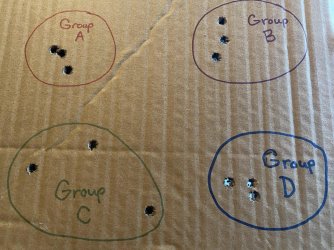PrairieHunter
Member
Hello resident experts!
While testing a batch of handloads yesterday, I experienced an interesting variance in my ladder test. Attached is an image of my groups for reference.
My test was run with a 7mm-08 Savage Axis II to find a good load for a surplus of 154gr. Hornady spire point bullets using H4350. Group A was a powder charge of 42.5 grains, Group B = 43, Group C = 43.5, and Group D = 44 grains.
Groups A, B, and D all shot within 1.1 inches, while Group C was a massive outlier at over 3 inches. I was shooting from my standard solid platform and felt steady on all shots. My question is why would there be a sudden spread in Group C when all other groups seemed to be pretty tight? I have heard of this phenomenon of a "mini spread" right before the tightest node is found in ladder testing, but have never before seen it this evident in the dozens of loads I have developed for 4 rifles.
Where do I go from here? I did not see any pressure signs at my highest powder charge, so I can keep increasing by .3 grains or so to see what those groups look like (max is around 46gr in most manuals). Or I could be perfectly happy to stick with one of the sub-MOA groups within this ladder. My concern is that a change of only +- 0.5 grains of powder can show that huge of a group blowout. I feel like I need to get at least 1.0 +- grains away from Group C to feel like I can maintain a nice tight group.
Any wisdom or opinions are welcome. Thanks in advance!
While testing a batch of handloads yesterday, I experienced an interesting variance in my ladder test. Attached is an image of my groups for reference.
My test was run with a 7mm-08 Savage Axis II to find a good load for a surplus of 154gr. Hornady spire point bullets using H4350. Group A was a powder charge of 42.5 grains, Group B = 43, Group C = 43.5, and Group D = 44 grains.
Groups A, B, and D all shot within 1.1 inches, while Group C was a massive outlier at over 3 inches. I was shooting from my standard solid platform and felt steady on all shots. My question is why would there be a sudden spread in Group C when all other groups seemed to be pretty tight? I have heard of this phenomenon of a "mini spread" right before the tightest node is found in ladder testing, but have never before seen it this evident in the dozens of loads I have developed for 4 rifles.
Where do I go from here? I did not see any pressure signs at my highest powder charge, so I can keep increasing by .3 grains or so to see what those groups look like (max is around 46gr in most manuals). Or I could be perfectly happy to stick with one of the sub-MOA groups within this ladder. My concern is that a change of only +- 0.5 grains of powder can show that huge of a group blowout. I feel like I need to get at least 1.0 +- grains away from Group C to feel like I can maintain a nice tight group.
Any wisdom or opinions are welcome. Thanks in advance!

